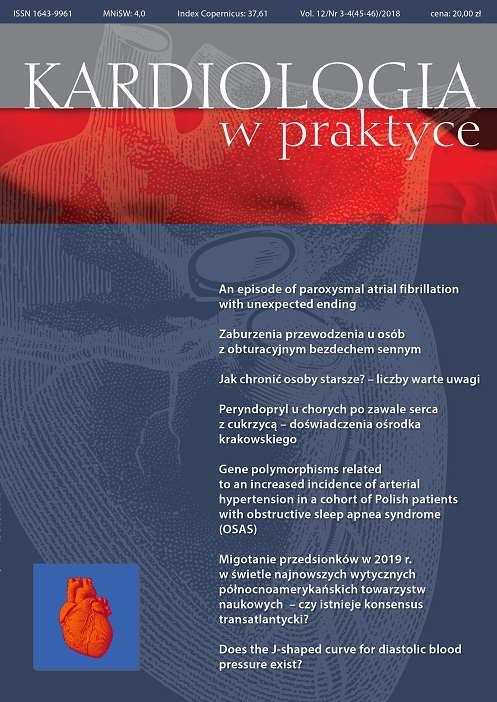How to protect the elderly? – numbers worth attention Review article
Main Article Content
Abstract
Hypertension prevalence among patients above 65 years of age is very high, reaching above 60%. Hypertension treatment among elderly is safe and significantly lowers morbidity and mortality. In HYVET and SPRINT trials the benefits of hypertension treatment were clear in all elderly patients subgroups. After the SPRINT trial results, in newly published ESC/ESH guidelines, the treatment target was lowered to 130/80 mmHg in patients above 65 and 80 years of age, providing it is well tolerated. The combination of perindopril/indapamide has been thoroughly investigated in elderly population and has proven its efficacy and safety. This combination lowers all-cause mortality (28%), stroke (34%) and heart failure (72%) rates as well as cardiovascular mortality. It also lowers the albuminuria and blood pressure without significant side effects. Moreover the efficient blood pressure control might protect elderly from cognitive deterioration and dementia development
Downloads
Article Details
Copyright: © Medical Education sp. z o.o. This is an Open Access article distributed under the terms of the Attribution-NonCommercial 4.0 International (CC BY-NC 4.0). License (https://creativecommons.org/licenses/by-nc/4.0/), allowing third parties to copy and redistribute the material in any medium or format and to remix, transform, and build upon the material, provided the original work is properly cited and states its license.
Address reprint requests to: Medical Education, Marcin Kuźma (marcin.kuzma@mededu.pl)
References
2. Staessen J.A., Fagard R., Thijs L. et al.: Randomised double-blind comparison of placebo and active treatment for older patients with isolated systolic hypertension. The Systolic Hypertension in Europe (Syst-Eur) Trial Investigators. Lancet 1997; 350(9080): 757-764.
3. Amery A., Birkenhager W., Bulpitt C.J. et al.: Syst-Eur. A multicentre trial on the treatment of isolated systolic hypertension in the elderly: objectives, protocol, and organization. Aging (Milano) 1991; 3(3): 287-302.
4. Dahlof B., Hansson L., Lindholm L.H. et al.: Swedish Trial in Old Patients with Hypertension (STOP-Hypertension) analyses performed up to 1992. Clin. Exp. Hypertens. 1993; 15(6): 925-939.
5. Beckett N.S., Peters R., Fletcher A.E. et al.: Treatment of hypertension in patients 80 years of age or older. N. Engl. J. Med. 2008; 358(18): 1887-1898.
6. Beckett N., Peters R., Leonetti G. et al.: Subgroup and per-protocol analyses from the Hypertension in the Very Elderly Trial. J. Hypertens. 2014; 32(7): 1478-1487; discussion 1487.
7. Warwick J., Falaschetti E., Rockwood K. et al.: No evidence that frailty modifies the positive impact of antihypertensive treatment in very elderly people: an investigation of the impact of frailty upon treatment effect in the HYpertension in the Very Elderly Trial (HYVET) study, a double-blind, placebo-controlled study of antihypertensives in people with hypertension aged 80 and over. BMC Med 2015; 13: 78.
8. Tzourio C., Anderson C., Chapman N. et al.: Effects of blood pressure lowering with perindopril and indapamide therapy on dementia and cognitive decline in patients with cerebrovascular disease. Arch. Intern. Med. 2003; 163(9): 1069-1075.
9. Peters R., Beckett N., Forette F. et al.: Incident dementia and blood pressure lowering in the Hypertension in the Very Elderly Trial cognitive function assessment (HYVET-COG): a double-blind, placebo controlled trial. Lancet Neurol. 2008; 7(8): 683-689.
10. Beckett N., Peters R., Tuomilehto J. et al.: Immediate and late benefits of treating very elderly people with hypertension: results from active treatment extension to Hypertension in the Very Elderly randomised controlled trial. BMJ 2011; 344: d7541.
11. Protogerou A., Blacher J., Stergiou G.S. et al.: Blood pressure response under chronic antihypertensive drug therapy: the role of aortic stiffness in the REASON (Preterax in Regression of Arterial Stiffness in a Controlled Double-Blind) study. J. Am. Coll. Cardiol. 2009; 53(5): 445-451.
12. Mogensen C.E., Viberti G., Halimi S. et al.: Effect of low-dose perindopril/indapamide on albuminuria in diabetes: preterax in albuminuria regression: PREMIER. Hypertension 2003; 41(5): 1063-1071.
13. Roush G.C., Ernst M.E., Kostis J.B. et al.: Head-to-head comparisons of hydrochlorothiazide with indapamide and chlorthalidone: antihypertensive and metabolic effects. Hypertension 2015; 65(5): 1041-1046.
14. Senior R., Imbs J.L., Bory M. et al.: Indapamide reduces hypertensive left ventricular hypertrophy: an international multicenter study. J. Cardiovasc. Pharmacol. 1993; 22(supl. 6): S106-110.
15. Chen P., Chaugai S., Zhao F., Wang D.W.: Cardioprotective Effect of Thiazide-Like Diuretics: A Meta-Analysis. Am. J. Hypertens 2015; 28(12): 1453-1463.
16. Prevention of stroke by antihypertensive drug treatment in older persons with isolated systolic hypertension. Final results of the Systolic Hypertension in the Elderly Program (SHEP). SHEP Cooperative Research Group. Jama 1991; 265(24): 3255-3264.
17. Williams B., Mancia G., Spiering W. et al.: 2018 ESC/ESH Guidelines for the management of arterial hypertension. Eur. Heart J. 2018; 39(33): 3021-3104.
18. Williamson J.D., Supiano M.A., Applegate W.B. et al.: Intensive vs Standard Blood Pressure Control and Cardiovascular Disease Outcomes in Adults Aged >/=75 Years: A Randomized Clinical Trial. Jama 2016; 315(24): 2673-2682.

